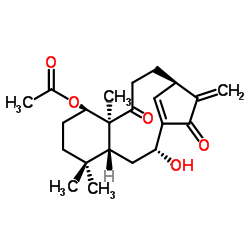Kongensin A
Modify Date: 2025-08-25 00:30:30

Kongensin A structure
|
Common Name | Kongensin A | ||
|---|---|---|---|---|
| CAS Number | 885315-96-8 | Molecular Weight | 374.471 | |
| Density | 1.2±0.1 g/cm3 | Boiling Point | 525.7±50.0 °C at 760 mmHg | |
| Molecular Formula | C22H30O5 | Melting Point | N/A | |
| MSDS | N/A | Flash Point | 178.4±23.6 °C | |
Use of Kongensin AKongensin A is a natural product isolated from Croton kongensis. Kongensin A is an effective, covalent HSP90 inhibitor that blocks RIP3-dependent necroptosishas. Kongensin A is a potent necroptosis inhibitor and an apoptosis inducer. Kongensin A has potential anti-necroptosis and anti-inflammation applications[1]. |
| Name | Kongensin A |
|---|---|
| Synonym | More Synonyms |
| Description | Kongensin A is a natural product isolated from Croton kongensis. Kongensin A is an effective, covalent HSP90 inhibitor that blocks RIP3-dependent necroptosishas. Kongensin A is a potent necroptosis inhibitor and an apoptosis inducer. Kongensin A has potential anti-necroptosis and anti-inflammation applications[1]. |
|---|---|
| Related Catalog | |
| Target |
HSP90[1] RIP3[1] Apoptosis[1] |
| In Vitro | Kongensin A (0-15 μM; 6 hours; HT29 cells) treatment induces caspase activation and apoptosis in multiple cancer cell lines in a dosage-dependent manner[1]. Kongensin A (0-15 μM; 24 hours; HT29 cells) treatment induces the degradation of RIPK1 and oncogenic kinases such as ERBB2, AKT, EGFR, and B-raf, and induces the up-regulation of HSP90A and HSP90B[1]. Kongensin A covalently binds to cysteine 420 in the middle domain of HSP90 and dissociates HSP90 from its cochaperone CDC37. The HSP90-CDC37 complex is required for RIP3 activation, KA blocks LPS/Smac mimetics/Z-VAD and RIP3 polymerization-induced cell death, in which cell death is dependent on RIP3 but not its upstream kinase RIP1[1]. Apoptosis Analysis[1] Cell Line: HT29 cells Concentration: 0 μM, 2.5 μM, 5 μM, 15 μM Incubation Time: 6 hours Result: Induced caspase activation and apoptosis in a dosage-dependent manner. Western Blot Analysis[1] Cell Line: HT29 cells Concentration: 0 μM, 2.5 μM, 5 μM, 15 μM Incubation Time: 24 hours Result: Induced the degradation of RIPK1 and oncogenic kinases such as ERBB2, AKT, EGFR, and B-raf, and induced the up-regulation of HSP90A and HSP90B. |
| References |
| Density | 1.2±0.1 g/cm3 |
|---|---|
| Boiling Point | 525.7±50.0 °C at 760 mmHg |
| Molecular Formula | C22H30O5 |
| Molecular Weight | 374.471 |
| Flash Point | 178.4±23.6 °C |
| Exact Mass | 374.209320 |
| PSA | 80.67000 |
| LogP | 2.77 |
| Vapour Pressure | 0.0±3.1 mmHg at 25°C |
| Index of Refraction | 1.542 |
| InChIKey | NUUWPMNNBHROPI-ASAQZKIWSA-N |
| SMILES | C=C1C(=O)C2=CC1CCC(=O)C1(C)C(OC(C)=O)CCC(C)(C)C1CC2O |
| Hazard Codes | Xi |
|---|
| 10,7-Metheno-7H-benzocycloundecene-8,13-dione, 1-(acetyloxy)-1,2,3,4,4a,5,6,9,10,11,12,13a-dodecahydro-6-hydroxy-4,4,13a-trimethyl-9-methylene-, (1R,4aR,6R,10R,13aS)- |
| (2R,4R,8R,9S,13R)-2-Hydroxy-5,5,9-trimethyl-14-methylene-10,15-dioxotricyclo[11.2.1.0]hexadec-1(16)-en-8-yl acetate |